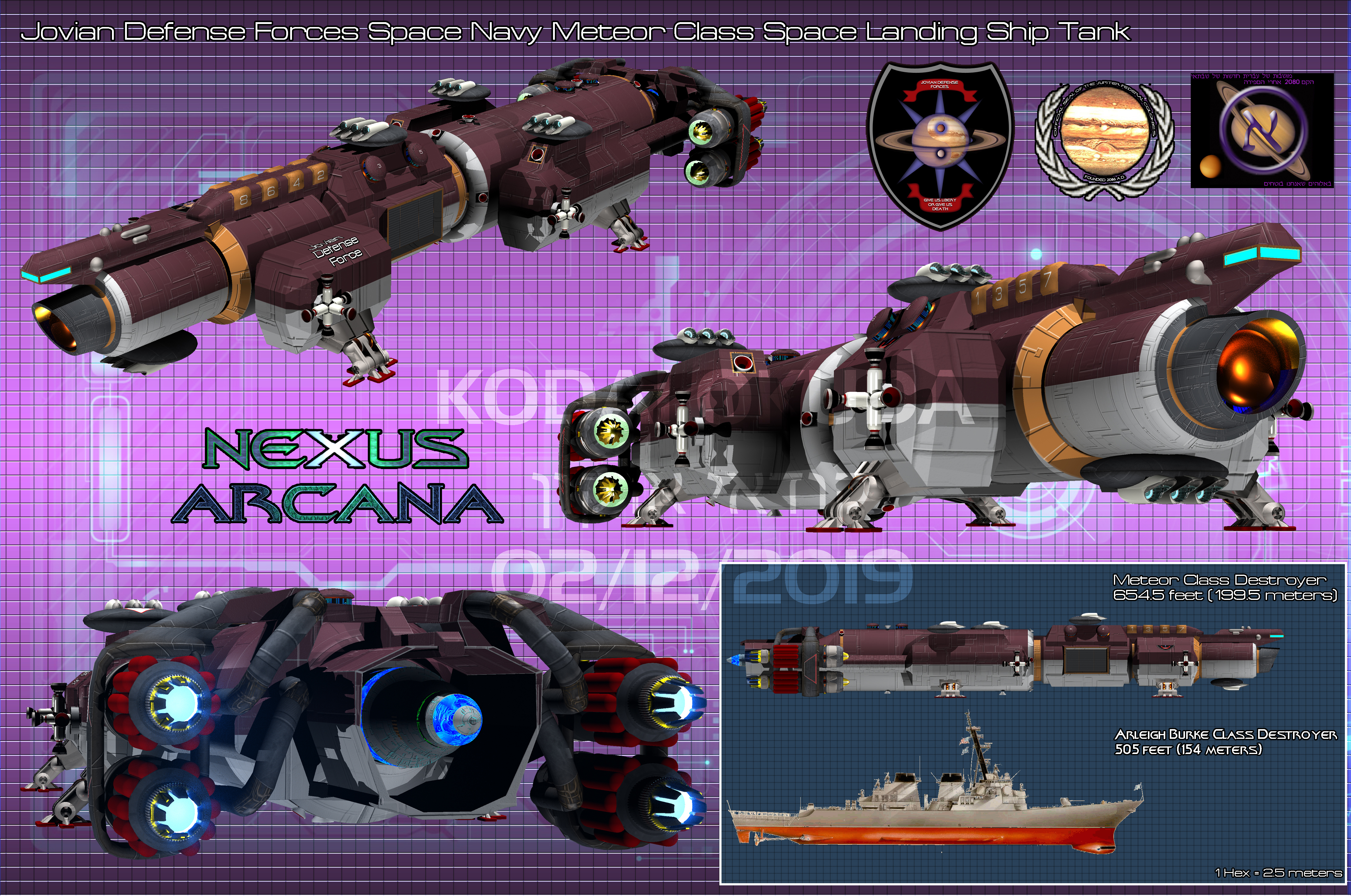SPECIFICATIONS

GOVERNMENT: Jovian Defense Forces
TYPE: Interstellar Astro-LST/Frigate (Landing Ship Transport) Triumph Class Refit
MODEL: Meteor class SDDG-78 (Ironclad Mark-III)
DATE INTRODUCED: 2178 AD
LENGTH: 654.5 feet (199.5 meters)
WIDTH: 186.4 feet (56.8 meters)
HEIGHT: 99.7 feet (30.4 meters)
MATERIAL: Crystal Composite
POWER PLANT: Macrotechnologies IPFF-5000 Ion Plasma Fusion Furnace x 6
OUTPUT: 30,000 megawatts
ARMOR TYPE: Crystal Composite
ARMOR THICKNESS: 1.5 inches
DISPLACEMENT: 6500 tons
CREW: 92 (7 Operators, 32 Gunners, 8 Officers, 7 Engineers, 7 Technicians, 7 Electricians, 4 Medical, plus 20 pilots.)
PROPULSION
FASTER THAN LIGHT DRIVE :
1x Pallas Research PRID-T2-800 Type-2-Mark-II intersection drive unit
SPEED: .15 light years per hour maximum warp
SUBLIGHT DRIVE::
4x Lunar Dynamics PD-2000 plasma drives
SPEED: kiloMACH 3.1 each or 0.07C each (2,345,000 mph each or .28C total for all four engines combined)
WEAPONS:
PRIMARY (OFFENSIVE):
4x Militia Military Industries MMI-PC-3180 540-megawatt triple PHELAC turrets; Effective Range: 1600 miles; Payload: unlimited with nuclear battery clutch system; ROF: 3 blasts every twenty seconds with a cyclic rate of 9 blasts per minute.
SECONDARY (OFFENSIVE):
8x Lithgear LG-CML-5000 cruise missile launcher; Missile Type: UN-SRT-5000 short-range 5000-pound computer-guided cruise missile/space torpedo (597.5 kiloton nuclear warhead); Effective Range: 35.1 miles; Payload: 2 cruise missiles each in a forward facing retractable missile silo; ROF: 1 torpedo each.
ELECTRONICS:
1x Microwave Radio Communications array with a 1000 AU range.
1x Super Luminal Velocity Communications Suite with a range of 1 light year.
1x LADAR array with a range of 220,000 miles.
1x Passive EMS array with a range of 1,000,000 miles.
1x Active EMS array with a range of 100,000 miles.
1x Super Luminal Velocity Sensor Suite with a range of 1 parsec (3.26 light years).
2x Gravitational/Antigravity Control Unit; Effect: Provides artificial lift, g-force compensation, and enhanced maneuverability. One for Intersection Drive.
DEFENSIVE SYSTEMS:
6x Cydonia Research CR-DF-1000 omnidirectional LEVEL-1 Gravitonic deflector field generator; Range: 1000 feet from hull; Power Requirement: 1000 megawatts each; Output: 180 terajoules with a regeneration of 18 terajoules every ten seconds.
HANGAR BAYS:
1x 1600-yd3ground-assault hangar that holds up to twenty Main Battle Robots, normally fifteen MBR-01C and five MBR-01B1s.
Description/Overview:
The SDDG-78 Meteor class was the second class of former UN Solar Empire ships that the JDF put into production in 2178 as part of their emergency military build-up. The Triumph class was slightly enlarged, and the new Meteor version of it used the same weapons and engine-extension that the Narvi Class. This provided the Meteor with sublight engines that could achieve a measurable percentage of the speed of light. With that speed, the Meteor class could be used as a Extra-Solar Expeditionary fleet scout ship that could jump into a star system, scout it out for habitable planets, and if found, could land on a habitable extra-solar planet to determine if it was suitable for colonization. While the Meteor was initially intended for use as part of the Jovian Defense Forces fleets within the Sol System, it's secondary purpose (and the one it excelled at) was as part of the colonization fleets that started leaving the Sol system in late 2178 to 2181 (24 fleets total). The range of the Meteor from their parent colony fleet was 10-light years from the core ship (a Township class colony ship). How many Meteor class ships survived their colony fleet expeditions is not known as many of the early colony fleets vanished into the depths of the galaxy.


